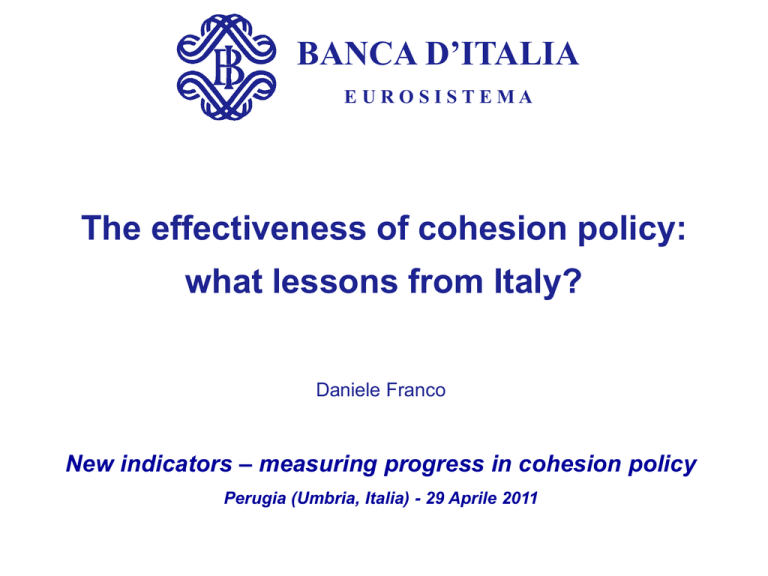The effectiveness of cohesion policy: *what lessons from Italy
advertisement

BANCA D’ITALIA EUROSISTEMA The effectiveness of cohesion policy: what lessons from Italy? Daniele Franco New indicators – measuring progress in cohesion policy Perugia (Umbria, Italia) - 29 Aprile 2011 Italy’s Regional Policy in the past decade 2 Italy’s New Regional Policy (NRP): an extensive information system The NRP - started in the late 1990s - aimed at spurring growth and creating social capital It gave special attention to the involvement of local communities in the policy design (exploiting local knowledge; bottom up approach) It made a great effort to develop an extensive information system on local economies, which can also be used to measure policy performance The database “Indicatori di contesto chiave e variabili di rottura” was a joint effort of Istat and the Ministry of the Economic Development to serve as a quantitative support for the Objective 1 2000-2006 programming period. It has become an important tool for the analysis of regional imbalances The database includes about 170 indicators for all regions on Environment, Energy, Competitiveness, International trade, Crime, Social capital, R&D, etc. 3 Some indicators were used in an outcome-based financing scheme: Obiettivi di servizio Obiettivi di servizio - adopted for the programming period 2007-2013 - is an outcomes-based financing scheme Public funds are disbursed on the basis of the results obtained by local governments in four areas: education, child- and elderly-care, waste disposal, water provision. The incentive scheme is based on 11 quantitative indicators Recent assessments show some positive results (e.g. improving the quality of administrative procedures) and some critical aspects. Two aspects deserve further scrutiny: - the achievement of the target can be influenced by external factors that are out of the control of local governments - very specific objectives are easily measurable but can encourage opportunistic behaviour (e.g. a local government may concentrate all its efforts on reaching the objectives subject to conditionality disregarding other important services) 4 The shortcomings of the New Regional Policy ● Shortcomings: - There were problems with setting priorities (too many), overlapping responsibilities, etc. - Not enough attention was paid to the effects of ordinary policies in the South. The quality of public services (justice, education, etc. ) is generally worse than in the Centre North. Capital spending is less efficient. Regional policies cannot offset these effects: additional capital expenditure in the South is about ½ of total capital expenditure in the area. It is about 5% of total public spending in the South (Source: Cannari, Magnani and Pellegrini, 2010) - Incentive schemes were largely ineffective (Source: De Blasio e Lotti, 2008) 5 The catching-up process did not really resume Ratio of the per capita GDP of the South to that of the Centre and North (Percentage values, current values) 65.0 60.0 55.0 50.0 45.0 1975 1980 1981 1982 1983 1984 1985 1986 1987 1988 1989 1990 1991 1992 1993 1994 1995 1996 1997 1998 1999 2000 2001 2002 2003 2004 2005 2006 2007 2008 1970 1963 1951 40.0 6 Inadequate public services 7 Education: gaps with respect to the Centre-North Students’ performance in Maths (InValSI*) (secondary school; quartiles; 2005-06) There are gaps in the quantity of education (school attendance ratios) There are gaps in the quality of education, increasing with the age of pupils Infrastructures are in worse conditions Dark colours identify better learning performance (source: Cipollone, Montanaro and Sestito, 2009) * National Institute for the Evaluation of the Education System 8 Health: patients move to the Centre-North, current per capita spending is higher in the South (but the capital stock is lower) Net flows of patients Public spending on hospital care (national average 2004-06=100) Dark colours identify inflows of patients and lower per capita (age-adjusted) public spending on hospital care 9 Hospital care: large gaps in the quality perceived by patients between rich and poor regions Satisfaction with hospital care for residents in some European cities (index 0-100) 10 Justice and waste disposal: worse services in the South (all local services are usually worse) Civil justice: lenght of ordinary trials (quartiles; days; 2006) Separate waste collection (quartiles; percentage values; 2007) Dark colours identify faster civil justice procedures and a higher incidence of garbage recycling 11 Doing business: more difficult in the South Cost and time of doing business (indexes; 2008) ● Average of 5 indicators concerning: - starting a company - getting a construction licence - transferring a property - enforcing contracts - closing down a company Dark colours identify contexts in which doing business is easier. (Source: Bianco and Bripi, 2009) 12 The role of public infrastructures 13 Poorer infrastructure endowments in the Mezzogiorno 120 100 80 60 40 20 0 Mezzogiorno Italia Index: Italy=100; data refer to 2009. (Source: Istituto Tagliacarne) 14 Education: more buildings with technical deficiencies in the Mezzogiorno Percentage points, data refer to 2000. (Source: Ministero della Pubblica Istruzione) 15 Public investment spending vs physical measures of infrastructural endowments: infrastructures seem more costly in the South 140 120 100 80 60 40 20 Public capital/GDP South and Islands Centre North West North East 0 Indexes based on physical measures Percentage values; physical measures are scaled on population size and land area (Sources: Istituto Tagliacarne and Di Giacinto, Micucci and Montanaro, 2009) 16 Technical and administrative time needed to plan and assign public works 1.500 1.400 1.300 1.200 Islands 1.100 South South 1.000 Centre days 900 North West 800 North East 700 600 500 400 300 200 100 0 2000 2004 2007 2000 External planning 2004 2007 Design approval 2000 2004 2007 Notice announcement 2000 2004 Offer submission 2007 2000 2004 2007 Adjugement Numbers of days (Source: Autorità per la vigilanza sui contratti pubblici) 17 Composition of capital expenditure: ordinary resources are greater in the Centre-North 1000 900 800 700 600 500 400 300 200 100 0 South and Islands Ordinary resources Centre and North FAS and European funds Per capita expenditure in real terms. Base year: 2000. Averages 1998-2007 (Source: DPS-Conti pubblici territoriali) 18 Per capita capital spending: the South is losing its advantage Per capita expenditure in real terms. Base year: 2000. (Source: DPS-Conti pubblici territoriali and Quadro unico finanziario) 19 Ineffective incentive schemes 20 Empirical work on incentives to firms points to modest effects ● Incentives (Law 488, Law 388) have mostly subsidised investments that would have been carried out anyway or cause changes in the timing of the projects (anticipation effect) ● Bank of Italy’s 2008 survey of 4000 companies: additional investment amounted to 30% of subsidies (but only 6% excluding changes in timing of projects) ● “Patti territoriali”: dynamics of employment and plants in municipalities within the Pacts not different from those of similar municipalities outside the Pacts ● Ineffectiveness may reflect lengthy procedures, uncertainty about funding and policies, etc. (Source: de Blasio and Lotti, 2009) 21 EU and Italian reforms: common ground 22 The reform of EU cohesion policy Reforms aim at: (i) strengthening ex-post evaluation (ii) introducing conditionality Other important objectives are: (iii) enhancing strategic programming (in line with the strategy Europe 2020) (iv) increasing concentration of interventions on specific objectives (v) creating a closer interaction between different levels of government (European, national, regional, local) 23 The reform of Italy’s funds for regional development policies The new legislation under discussion for reforming Italy’s cohesion funds (within the fiscal decentralisation process) is consistent with the new European guidelines Key features will be the focus on some relevant projects, program evaluation, conditionality It would be useful: - to add a set of targets at the regional level, to complement those at the national level envisaged in Europe 2020 - to closely coordinate cohesion objectives with the fiscal decentralisation process underway (which is setting uniform - minimal - standards for the quality of public services across the country). E.g. improving education & health services may require better infrastructures in some regions 24 Indicators for moving towards an outcome-based mechanism in the delivery of cohesion policy 25 Indicators can be further improved The quality of public services in the Mezzogiorno is worse than in the rest of the country. There is a need for indicators measuring the performance of all entities producing public services (the level of students’ achievement, the performance of hospitals, the duration of judiciary procedures, etc.) The inadequate quality of public services also depends on infrastructural endowments. Capital expenditure is also less efficient in theMezzogiorno. Indicators evaluating infrastructural adequacy (quality of services, potential demand, economic impact) are needed. The monitoring of costs and time of realisation should be improved The separation between ordinary and additional expenditures is useful for accounting reasons. However, the two components should be considered jointly Improving standardized data collection for all European regions concerning cohesion spending (components, beneficiaries, etc.) and its effectiveness could be extremely useful to evaluate interventions 26 Indicators should be used to improve policies The creation of a close link between economic indicators (easily measurable by independent institutions and available to external researchers) and the mechanisms for rewards/sanctions may reinforce the effectiveness of policy actions Within the Italian decentralisation process, the central government will retain the power to intervene in case the quality of regional & local services is not adequate Public resources should be directed towards interventions that through ex-post evaluation - have proved to be effective. Ineffective programs should be discontinued 27 Conditionality should be well-designed One should be aware that the impact of cohesion policy can be limited by different obstacles for economic growth. Indicators on the difficulties of doing business at local level highlight some of these obstacles Some obstacles may concern areas of regional responsibility: - for example, entry barriers for new firms in the service sector Other obstacles may concern areas in which regions have no major role: - wage levels in Italy do not fully reflect local labour market conditions conditionality should reflect the scope for action of each government there is a need for close policy coordination across levels of government and sectors 28 More effective incentive schemes are needed (I) The design of the schemes and their implementation should ensure: Fast implementation of procedures: market competition requires fast decisions that are usually incompatible with the sluggishness of bureaucracy Simplicity: complex rules discourage companies, increase costs, increase legal conflicts Stability: firms’ investments are based on medium-long term plans; if rules change over time, incentives are less effective and benefit only the firms which would have carried out the investments anyway => Increase efforts to measure the quality of incentive schemes 29 More effective incentive schemes are needed (II) Transparency and accountability are crucial The objectives of a program should be explicitly stated Ex post evaluation should not be based on the observation of changes over time, which can be influenced by many factors, but on the estimate of the most likely scenario without the policy action (counterfactual analysis) Two aspects are crucial: (i) policy makers should collect and disclose the information that make ex post evaluation possible. E.g., data should be collected also for those who applied for the subsidy but did not receive it (ii) policy trials should be introduced for statistically significant groups. This would allow policy makers to close down ineffective programs 30 BANCA D’ITALIA EUROSISTEMA










